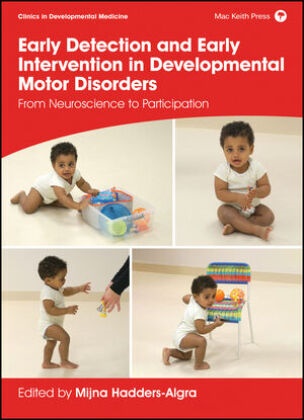Share
Fr. 134.00
M Hadders-Algra, Mijna Hadders-Algra, Mijna (University of Groningen) Hadders-Algra, Mijn Hadders-Algra, Mijna Hadders-Algra
Early Detection and Early Intervention in Developmental Motor Disorder - From Neuroscience to Participation
English · Hardback
Shipping usually within 1 to 3 weeks (not available at short notice)
Description
Informationen zum Autor Mijna Hadders-Algra (1956; MD, PhD) is professor of Developmental Neurology. Her research focuses on 1) early detection of developmental disabilities, 2) early intervention, 3) significance of minor neurological dysfunction (MND) in children with DCD, learning- and behavioural disorders, 4) pathophysiology of motor impairment in children with cerebral palsy or DCD. She is (co)author of >250 papers in peer-reviewed international journals and invited author of many chapters in handbooks in the field of developmental paediatrics. She frequently lectures and teaches across the world. Klappentext The book aims to provide a comprehensive overview of assessments and interventions applied in young children with, or at high risk, for developmental motor disorders. It provides an evidence-based practical guide for health professionals working in the field of early detection and early intervention (e.g., paediatricians and paediatric physiotherapists). Parts I & II provide an overview of the clinical picture of early detection and early intervention and the neurodevelopmental mechanisms occurring in early life are discussed, including vulnerability and plasticity. In Parts III & IV basic principles and features governing typical and atypical motor development are explained, covering not only motor development but also sensory and cognitive development. Part V summarises the methods available for assessments, including information on technical details of the tools and psychometric properties. Finally, Part VI discusses early intervention, including evidence on effectiveness, together with the application of equipment in young children with developmental motor disorders. Special attention is paid to the family and environmental adaptations. Zusammenfassung The book aims to provide a comprehensive overview of assessments and interventions applied in young children with, or at high risk, for developmental motor disorders. It provides an evidence-based practical guide for health professionals working in the field of early detection and early intervention (e.g., paediatricians and paediatric physiotherapists). Parts I & II provide an overview of the clinical picture of early detection and early intervention and the neurodevelopmental mechanisms occurring in early life are discussed, including vulnerability and plasticity. In Parts III & IV basic principles and features governing typical and atypical motor development are explained, covering not only motor development but also sensory and cognitive development. Part V summarises the methods available for assessments, including information on technical details of the tools and psychometric properties. Finally, Part VI discusses early intervention, including evidence on effectiveness, together with the application of equipment in young children with developmental motor disorders. Special attention is paid to the family and environmental adaptations. Inhaltsverzeichnis Author Appointments vii Foreword ix Preface xi Video Captions xiii Part 1: Introduction 1 1 Introduction 3 Mijna Hadders-Algra 2 Early Diagnosis and Early Intervention in the Clinic 9 Leena Haataji Part 2: Developmental Neurology 23 3 Neurodevelopmental Mechanisms in Early Life 25 Mijna Hadders-Algra Part 3: Typical Motor Development 39 4 Sensory, Language, Cognitive and Socio-Economic Development 41 Hayley C Leonard 5 Motor Development During Foetal Life and Early Infancy 58 Mijna Hadders-Algra 6 Motor Development Between 3 Months and 2 Years 70 Mijna Hadders-Algra Part 4: Atypical Motor Development 97 7 Atypical Motor Development of the Foetus and Young Infant 89 Mijna Hadders-Algra 8 Atypical Motor Development Between 3 Months and 2 Years 99 Author Appointments viiList of contents
Foreword ix
Preface xi
Video Captions xiii
Part 1: Introduction 1
1 Introduction 3
Mijna Hadders-Algra
2 Early Diagnosis and Early Intervention in the Clinic 9
Leena Haataji
Part 2: Developmental Neurology 23
3 Neurodevelopmental Mechanisms in Early Life 25
Mijna Hadders-Algra
Part 3: Typical Motor Development 39
4 Sensory, Language, Cognitive and Socio-Economic Development 41
Hayley C Leonard
5 Motor Development During Foetal Life and Early Infancy 58
Mijna Hadders-Algra
6 Motor Development Between 3 Months and 2 Years 70
Mijna Hadders-Algra
Part 4: Atypical Motor Development 97
7 Atypical Motor Development of the Foetus and Young Infant 89
Mijna Hadders-Algra
8 Atypical Motor Development Between 3 Months and 2 Years 99
Mijna Hadders-Algra and Lindsay Pennington
Part 5: Diagnostics: Assessment of Neuromotor Conditions In Early Childhood 113
9 Psychometric Properties of Standardized Tests 115
Barbara Sargent
10 Assessments in the Neonatal Period and Early Infancy 124
Alicia Jane Spittle and Mijna Hadders-Algra
11 Assessment of Infants and Toddlers 144
Annette Majnemer, Laurie Snider and Mijna Hadders-Algra
Part 6: Early Intervention 171
12 Early Intervention: What About the Family? 173
Peter Rosenbaum, Monika Novak-Pavlic, Schirin Akhbari Ziegler and Mijna Hadders-Algra
13 Early Intervention in the Neonatal Period 185
Mijna Hadders-Algra
14 Early Intervention in the First 2 Years Post-Term 198
Mijna Hadders-Algra
15 Environmental Adaptations 228
Gunilla Thunberg, Roslyn Livingstone, Margaret Buchholz and Debra Field
16 Concluding Remarks 242
Mijna Hadders-Algra
Index 247
Product details
| Authors | M Hadders-Algra, Mijna Hadders-Algra, Mijna (University of Groningen) Hadders-Algra |
| Assisted by | Mijn Hadders-Algra (Editor), Mijna Hadders-Algra (Editor) |
| Publisher | MacKeith Press |
| Languages | English |
| Product format | Hardback |
| Released | 31.03.2021 |
| EAN | 9781911612438 |
| ISBN | 978-1-911612-43-8 |
| No. of pages | 288 |
| Subjects |
Natural sciences, medicine, IT, technology
> Medicine
Neurologie, Medizin, Entwicklungsstörung, Neurology, Medical Science |
Customer reviews
No reviews have been written for this item yet. Write the first review and be helpful to other users when they decide on a purchase.
Write a review
Thumbs up or thumbs down? Write your own review.

